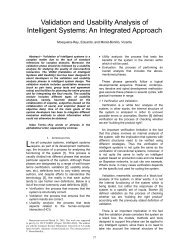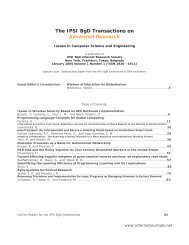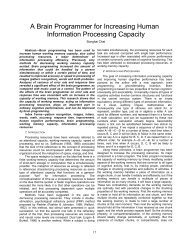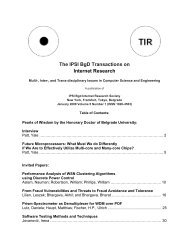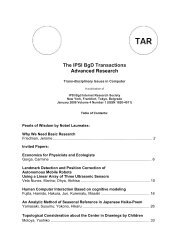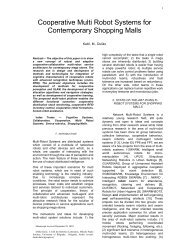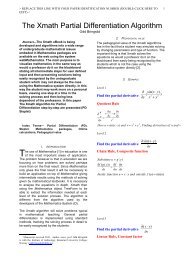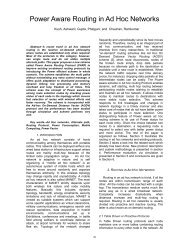The IPSI BgD Transactions on Internet Research - Welcome
The IPSI BgD Transactions on Internet Research - Welcome
The IPSI BgD Transactions on Internet Research - Welcome
You also want an ePaper? Increase the reach of your titles
YUMPU automatically turns print PDFs into web optimized ePapers that Google loves.
including placeholders and references to<br />
templates to the hyperlinks. It introduces the<br />
access sequence number that tracks a user’s<br />
access, which is incremented each time the user<br />
of the current sessi<strong>on</strong> accesses a XHTML<br />
document or its XML/XAL equivalence through a<br />
hyperlink. This paper also introduces the<br />
algorithm for a generic Comm<strong>on</strong> Gateway<br />
Interface (CGI) script, implemented in the Perl<br />
language, that handles the events of the access<br />
through hyperlinks. This paper uses a database<br />
managed by a Relati<strong>on</strong>al Database Management<br />
System (RDBMS) to track and update the access<br />
sequence number. Hoffer et al. [7] covers the<br />
RDBMS technology. This paper presents <strong>on</strong>e<br />
c<strong>on</strong>crete example for the implementati<strong>on</strong> that an<br />
XHTML document or its XML/XSL equivalence<br />
for a company’s ph<strong>on</strong>e directory is listed through<br />
a hyperlink <strong>on</strong> the company’s intranet home<br />
page. In this paper, after the encrypti<strong>on</strong> method<br />
is applied to the hyperlink reference, two<br />
scenarios will be discussed. <str<strong>on</strong>g>The</str<strong>on</strong>g> first scenario is<br />
that a valid user accesses the ph<strong>on</strong>e directory<br />
through the hyperlink and gets through. <str<strong>on</strong>g>The</str<strong>on</strong>g><br />
sec<strong>on</strong>d scenario is that an outside intruder<br />
attempts to access the ph<strong>on</strong>e directory and is<br />
denied the access.<br />
2. SECURITY ARCHITECTURE FOR WEB OBJECTS<br />
Figure 1 describes an object model for a client<br />
machine that hosts a web browser applicati<strong>on</strong>,<br />
which accesses web or XML documents <strong>on</strong> web<br />
servers in a company’s intranet or the <strong>Internet</strong>.<br />
<str<strong>on</strong>g>The</str<strong>on</strong>g> rest of this paper c<strong>on</strong>siders a web page or<br />
an XML document as an object instance of the<br />
WebDocument object class. For an ease of<br />
discussi<strong>on</strong>, this paper c<strong>on</strong>centrates the<br />
discussi<strong>on</strong> <strong>on</strong> web pages up to Secti<strong>on</strong> 5.<br />
Discussi<strong>on</strong>s <strong>on</strong> XML documents will follow <strong>on</strong><br />
Secti<strong>on</strong> 6.<br />
When the browser requests a web page from a<br />
web server, the web server downloads the web<br />
page to the client machine to be rendered by the<br />
browser and displayed to the user.<br />
In object-oriented terminology, a relati<strong>on</strong>ship<br />
am<strong>on</strong>g object classes is called an associati<strong>on</strong>.<br />
Binary associati<strong>on</strong>, the associati<strong>on</strong> between two<br />
classes, is the most comm<strong>on</strong> <strong>on</strong>es. In some<br />
cases, an object class may be associated with<br />
itself due to that it has two roles, for example, a<br />
pers<strong>on</strong> class that models a company’s workers<br />
may have two roles: manager and employee.<br />
Such an associati<strong>on</strong> is called the unary<br />
associati<strong>on</strong>.<br />
Figure 1 shows examples of binary<br />
associati<strong>on</strong>s. One of them is the associati<strong>on</strong><br />
between the WebServer class and the<br />
WebDocument class. Figure 1 also shows<br />
examples of unary associati<strong>on</strong>s. One of them is<br />
the associati<strong>on</strong> between web pages that c<strong>on</strong>tain<br />
4<br />
instances of the XHTML anchor tag for hyperlink:<br />
, referred as the link source, and<br />
the web pages identified by the web address’ url,<br />
referred as the link target. For each web page as<br />
an instance of the WebDocument class, there<br />
may be zero or more hyperlinks c<strong>on</strong>tained<br />
therein. Each web page may also be referred to<br />
as link reference by zero or more web pages.<br />
Figure 1 shows the multiplicity reflecting the<br />
many-to-many associati<strong>on</strong>. For a many-to-many<br />
associati<strong>on</strong>, it is necessary to create an<br />
associati<strong>on</strong> class to correctly model the<br />
associati<strong>on</strong> because there may be attributes that<br />
bel<strong>on</strong>g more appropriately to the associati<strong>on</strong><br />
rather than to the WebDocument class. <str<strong>on</strong>g>The</str<strong>on</strong>g><br />
associati<strong>on</strong> class is depicted as SecurityWrapper<br />
in Figure 1. This associati<strong>on</strong> class may model<br />
security methods such as encrypti<strong>on</strong> and<br />
database management system (DBMS) facilities<br />
for the web pages. Blaha et al. [2] discusses in<br />
detail the associati<strong>on</strong> class.<br />
ClientHost<br />
+netSource<br />
SecurityNode<br />
0..*<br />
Serve<br />
0..*<br />
0..*<br />
NetworkMachine<br />
0..* +netTarget<br />
0..* +linkSource<br />
WebDocument +linkReference<br />
0..*<br />
0..*<br />
Store<br />
1<br />
WebServer<br />
Access<br />
ReferTo<br />
1..*<br />
0..*<br />
MiddleTierMachine<br />
+midTierTarget<br />
Database<br />
Server<br />
SecurityWrapper<br />
Figure 1. Object Model for the Security Architecture<br />
<str<strong>on</strong>g>The</str<strong>on</strong>g> communicati<strong>on</strong> protocol between the client<br />
machine and the web server is HTTP. Data<br />
packets are transmitted between the client and<br />
server through network machines, which are<br />
modeled as the object class NetworkMachine in<br />
Figure 1. Examples of the network machines are<br />
hubs, switches, routers, domain name servers,<br />
and so <strong>on</strong>. A network machine may transmit<br />
data packets to many other network machines.<br />
C<strong>on</strong>versely a network machine may also receive<br />
data packets transmitted from many other<br />
network machines. So this associati<strong>on</strong> is a many<br />
to many unary associati<strong>on</strong>. From the same<br />
reas<strong>on</strong> stated above, it is necessary to create an<br />
associati<strong>on</strong> class for this many-to-many<br />
associati<strong>on</strong>. This associati<strong>on</strong> class may model a<br />
security node that enforces security for data<br />
transmissi<strong>on</strong> depicted as SecurityNode in Figure<br />
0..*<br />
+midTierSource<br />
0..*<br />
MidTierSecurity



